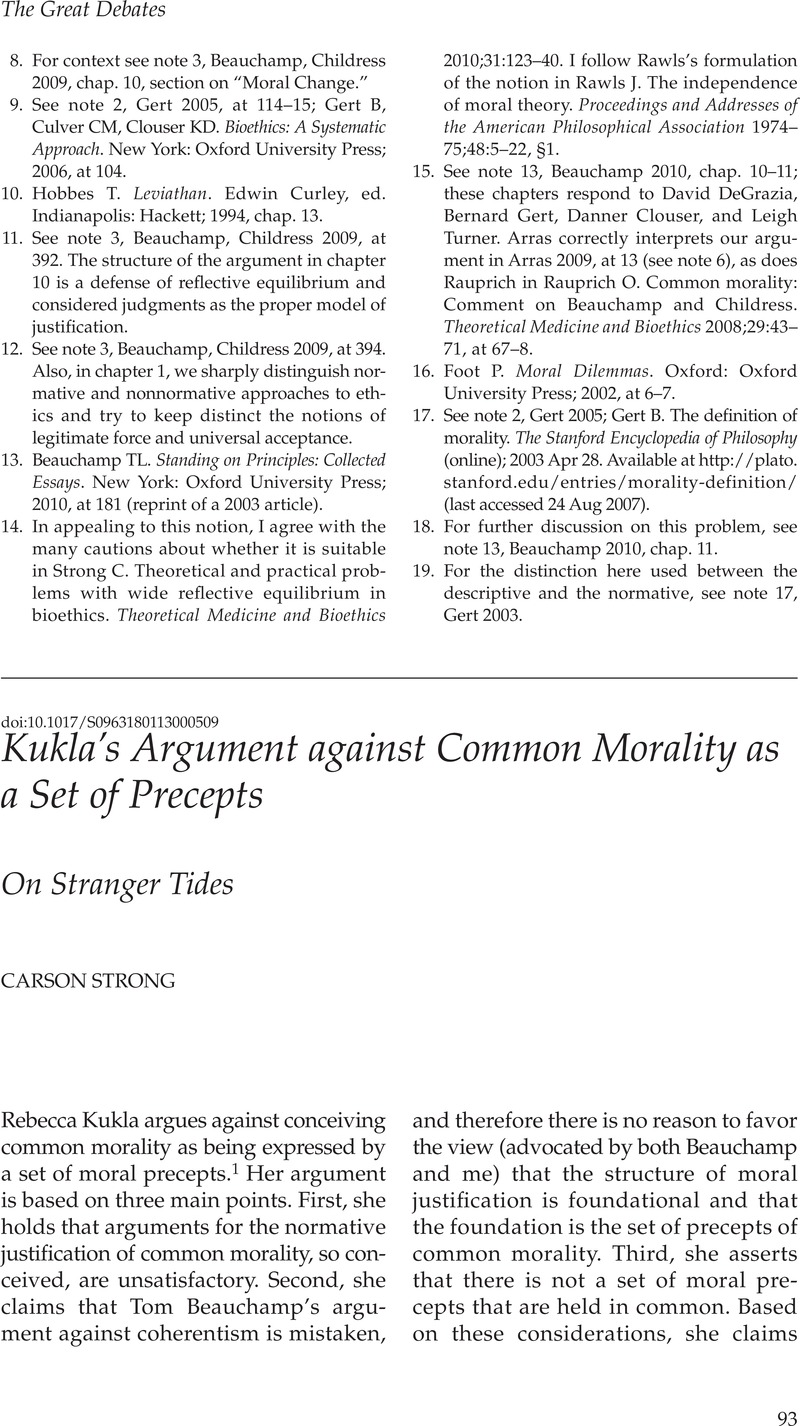On Stranger Tides
Published online by Cambridge University Press: 20 November 2013

1. Kukla, R. Living with pirates: Common morality and embodied practice. Cambridge Quarterly of Healthcare Ethics 2014;23:75–85CrossRefGoogle ScholarPubMed. I use the term “precepts” broadly to refer not only to principles, which are the main focus of Kukla’s comments, but also to moral rules, statements advocating the virtues, assertions of rights, and moral judgments about paradigm cases, among other components of common morality.
2. Gert, B. Morality: Its Nature and Justification. Rev. ed. New York: Oxford University Press; 1998Google Scholar. There is room for debate over how to formulate the purpose of morality, but I’ll leave that for another occasion.
3. Strong, C. Justifying group-specific common morality. Theoretical Medicine and Bioethics 2008;29:1–15.Google Scholar
4. See note 3, Strong 2008, at 10–11.
5. See note 3, Strong 2008, at 11.
6. I have discussed the role common morality in the descriptive sense might have in the justification of common morality in the normative sense. See note 3, Strong 2008, at 14.
7. Rawls, J. A Theory of Justice. Cambridge, MA: Harvard University Press; 1971.Google Scholar
8. See, e.g., Brandt, RB. A Theory of the Good and the Right. Amherst, NY: Prometheus Books; 1979Google Scholar, at 20; Little, D. Reflective equilibrium and justification. Southern Journal of Philosophy 1984;22:3373–87Google Scholar; Haslett, DW. What is wrong with reflective equilibrium? Philosophical Quarterly 1987;37:305–11.Google Scholar
9. Beauchamp, TL, Childress, JF. Principles of Biomedical Ethics. 6th ed.New York: Oxford University Press; 2009, at 384.Google Scholar
10. Daniels, N. Justice and Justification: Reflective Equilibrium in Theory and Practice. Cambridge: Cambridge University Press; 1996, at 5–6.CrossRefGoogle Scholar
11. Strong, C. Theoretical and practical problems with wide reflective equilibrium in bioethics. Theoretical Medicine and Bioethics 2010;31:123–40.Google Scholar
12. See note 10, Daniels 1996, at 23.
13. See note 10, Daniels 1996, at 338–9.
14. See note 11, Strong 2010, at 132–4; for an additional critique of reflective equilibrium, see Arras, J. The way we reason now: Reflective equilibrium in bioethics. In: Steinbock, B, ed. The Oxford Handbook of Bioethics. New York: Oxford University Press; 2009:46–71.Google Scholar
15. See note 3, Strong 2008, at 2–4.
16. For more on this point, see note 3, Strong 2008, at 5–6.
17. This point is derived, with some modification, from Gert, B, Culver, CM, Clouser, KD. Bioethics: A Return to Fundamentals. New York: Oxford University Press; 1997, at 16–17.Google Scholar
18. See Adams, RM. Religious ethics in a pluralistic society. In: Outka, G, Reeder, JP Jr, eds. Prospects for a Common Morality. Princeton, NJ: Princeton University Press; 1993:94–5.Google Scholar
19. Reference is being made to the movie Pirates of the Caribbean: On Stranger Tides, Disney Enterprises, Inc., 2011, and to the novel on which it is based: Powers T. On Stranger Tides. New York: Harper; 1987.